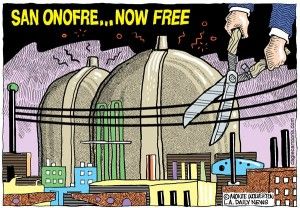San Onofre gets nuked
By Joseph Perkins
“VICTORY!” So reads the giddy headline on the Friends of the Earth website.
The anti-nuke environmental group is celebrating the surrender of Southern California Edison, which announced last week it will permanently shutter its San Onofre Nuclear Plant.
“This is very good news for the people of Southern California,” said Friends of the Earth president Erich Pica, in a statement.
So Cal Ed’s customers “now have the opportunity,” he said, “to move away from the failed promise of dirty and dangerous nuclear power and replace it with safe and clean energy provided by the sun and the wind.”
Of course, Pica neglected to mention how much it will cost So Cal Ed customers to replace San Onofre’s 2200 megawatts — which accounted for nearly 20 percent of the utility’s total electricity production — with solar arrays and wind farms.
First, there’s the actual cost of decommissioning San Onofre, which will amount to roughly $3.4 billion, according to Ted Craver, chief executive officer of Edison International, So Cal Ed’s parent company.
The California Public Utilities Commission, which regulates electricity rates, will determine how much So Cal Ed ratepayers will be forced to pay for San Onofre’s permanent shut down.
Sempra Energy, which owns 20 percent of the nuclear plant, is counting on the CPUC to allow it to recoup its $519 million stake in San Onofre by passing along the cost to its customers.
By the same coin, So Cal Ed customers can be expected to absorb a couple billion dollars or so in higher electricity rates to defray the cost of decommissioning San Onofre.
Then there are Edison International shareholders, including the California Public Employees Retirement System. They will absorb after-tax costs of up to $425 million, according to Jim Scilacci, Edison’s chief financial officer, although, he warned, further write downs are possible. Because CalPERS payouts to retirees are guaranteed by the California Constitution, at least according to most interpretations, that means all California taxpayers could be on the hook for any investment losses.
And not to be forgotten are the 1,100 San Onofre employees who suddenly find themselves jobless with the plant’s shutdown. Pica, the Friends of the Earth president, doesn’t feel their pain. That’s because he lives and works all the way in Washington, D.C., where he doesn’t see the human toll of his anti-nuke advocacy in Southern California.
Replacement
Indeed, aside from the direct cost of decommissioning San Onofre, there also is the cost of replacing the atoms the nuclear plant generated “with energy provided by the sun and wind,” as suggested by Pica and Friends.
Indeed, as So Cal Ed has previously estimated, it would take 64,000 acres of solar panels — 100 square miles’ worth — to replace the electricity San Onofre generated on its 84-acre site in San Clemente. It would take 59,000 acres of wind turbines.
And even if such a vast amount of land could be assembled by a company planning to sell “safe and clean” solar or wind, it would face the same kind of reflexive opposition from environmental activist groups that San Onofre faced.
Just last year, for instance, the North Sky River Wind project, a 100-turbine, 12,781-acre wind farm in Kern County, was hit with a lawsuit from the Center from Biological Diversity, the Sierra Club, and Defenders of Wildlife. The groups sought to block the 297-megawatt project because it posed an “unacceptable risk” to Kern’s bird population.
Similarly, Defenders of Wildlife, the Sierra Club and the National Resources Defense Council filed suit last year against Calico Solar, which proposed to build a solar farm on 4,600 acres in the Mohave Desert. The enviros claimed the 663 megawatt project would endanger tortoises, lizards and other desert-dwelling critters.
Had Pica spoken up for North Sky River Wind, Calico Solar and other such wind and solar projects, his claim that the permanent removal of San Onofre’s 2,200 megawatts is “very good news” for the people of Southern California could be taken seriously.
That he has remained silent while other environmentalists attacked wind and solar projects suggests that Friends of the Earth is less concerned with promoting “green” energy than it is with killing nuclear energy.
Related Articles
New CARB Scoping Plan claims fighting ‘climate change’ is a ‘great unifier’
Yesterday the California Air Resources Board released the first update of its Climate Change Scoping Plan. The original Scoping Plan
A political form of reefer madness
April 9, 2012 By Steven Greenhut SACRAMENTO — Some Oakland residents are furious that on the same day a gunman murdered
Greenmail lives in San Diego, making PLA ban irrelevant
Nov. 9, 2012 By Chris Reed In June, San Diego voters overwhelmingly approved a ban on project labor agreements. But




